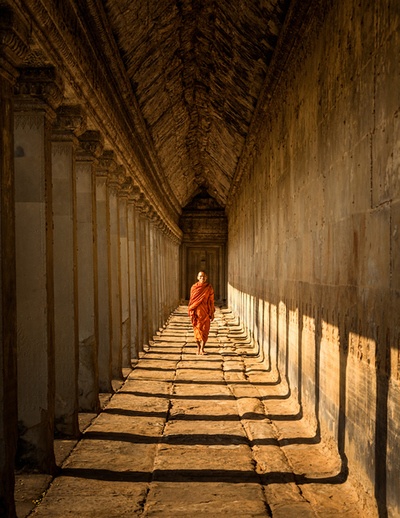Tailor Made Holidays with our travel experts
We'll do our best to call you within 48h

It is also one of the most highly expressive forms of art that still survive today. Court dance was not just a source of entertainment for the royal court. However it served many rituals whether public or private that continued right into the 20th century such as at coronations, funerals, honouring visiting head of state or for religious purposes. The dancers were often believed to be the medium between the gods that dwelled all around mankind, god-kings and mortals. Therefore court dance held many significant to the king, the people and the entire nation. The dancers would perform "boung soung" (paying respects to the heavenly deities) to promote and induce rain for plentiful crops better harvest, fertility to the land, peace and prosperity for the whole kingdom.
Court dance was generally assumed to have developed in the 9th century under King Jayavarman II (802-850) having returned from Indonesia. He also established the devaraja (god-king) cult and founded the Khmer empire that was to last for several centuries. During the Angkorean period from the 9th - 15th century A.D. many monuments began to appear and so did Khmer art that included temple deities and apsaras (celestial nymphs) that guarded the temples and entertained the gods. During the classical Angkorean age from 10th century to 14th century. Elegant apsaras began to appear in their thousands on temple gates, bas-reliefs, pillars, pediments etc... The elegant nymphs were found especially carved on the temple of Angkor Wat under the reign of King Suryavarman II (1113-1150) that was to serve as his final resting place, as well as a temple dedicated to the Hindu deity Vishnu. Angkor Wat also served as the finest example of Khmer art to the Khmer people.
In the 11th century one king gave one of his Brahmans the gift of ," one hundred beautiful magnificently adorned women... fifty orchestras, copper cymbals, drums etc." While in the 13th century the great King Jayavarman VII gave a temple that he had just built , "a thousand dancers and in the rest of the temples that covered the empire a total of one thousand six hundred and twenty-two dancers".
From the 15th century onwards, the Khmer Empire began to slowly decline, imposing temples were no longer constructed, and the imposing choreographic rituals slowly waned. A fatal blow came from it's neighbouring Siamese kingdom that used to be part of the Angkorean vassal state sacked the Khmer Empire's capital in 1431. Among their booty they took with them were: slaves, artisans, musicians and the entire royal dance troupe to their capital Ayuthaya. In the next four hundred years Cambodia entered the dark ages of it's history. Nothing is known about court dance until the middle of the 19th century under the reign of King Ang Duong (1796-1860) there saw the revival of Khmer arts. King Ang Duong was a patron of the arts, his kingdom flourished with artisans, sculptors, poets, literature, music and a royal dance troupe in his royal court. He set up his own dance troupe comprising of two troupes one female and one male. These two evolved separately into two different art forms that we see today. The male art form was supported by local governors and came to be known as lakhon khol (masked theatre). However the female troupe became the more dominant out of the two and came to be known was robam boran or lakhon kabach boran (royal court dance).
In the 1970s with the overthrow of the royal monarchy Khmer court dance began to decline and worst was to come during the Khmer Communist Revolution known as the Khmer Rouge era from 1975-79. The Khmer people suffered so much under this four year period that was known as the "Killing Fields". So many people died under starvation, persecution and execution. Khmer culture also suffered especially court dance and many other art forms. What documents or manuscripts that were recorded were all destroyed by the Khmer Rouge. Those dancers who could flee to neigbhouring refugee camps in Thailand kept the tradition alive and those who stayed behind were killed off. By 1979 there revival of Khmer art began a slow and painstaking task of finding the surviving teachers and what documents that were available to keep the art form alive. The sad irony is that court dance 90 per cent of the dancers had vanished as well as many other art forms were rarely recorded or documented. Everything was passed down orally from teacher to student for many hundreds of years. Once the link had been broken it was hard to recover that link. A year later court dance only had about a handful students that were recruited from orphanages that were taught be a mere handful of teachers.
During the reign of a new king a new dance troupe would be arranged by a matron of the royal court. Women were usually of royalty, relatives, concubines and wives. A woman according to her body type would be trained to play a single role. Tall and slender women would play male and female roles such as heroes and princess, while women with strong and large body types would play the roles of giants and villains. Men only had small roles such as clowns and hermits. It was later generation that the role of the monkey was played by men.
Less than a decade later court dance was alive again with more than one hundred students learning this ancient traditional art form in Phnom Penh. The loss is still great with about a third of the dance repertoires- the steps- gesture, movements, narratives-survived intact. However there seemed to be a lot of support to see this art form ancient with such exquisite beauty and refinement that is rankemigration vietnamienne qui estˆ plus originaire de cetterd as just one of the world's oldest traditions.